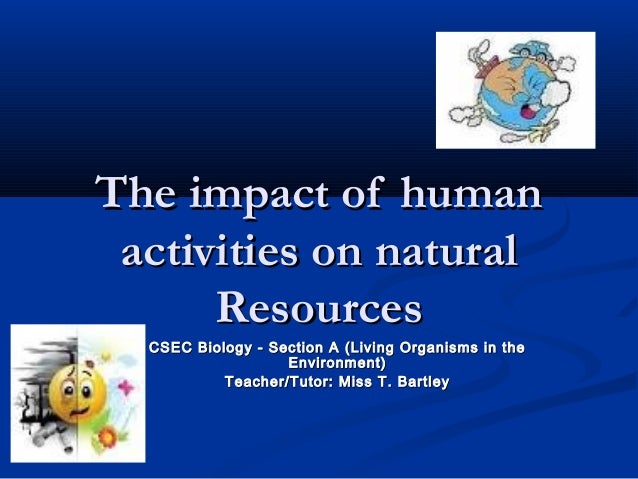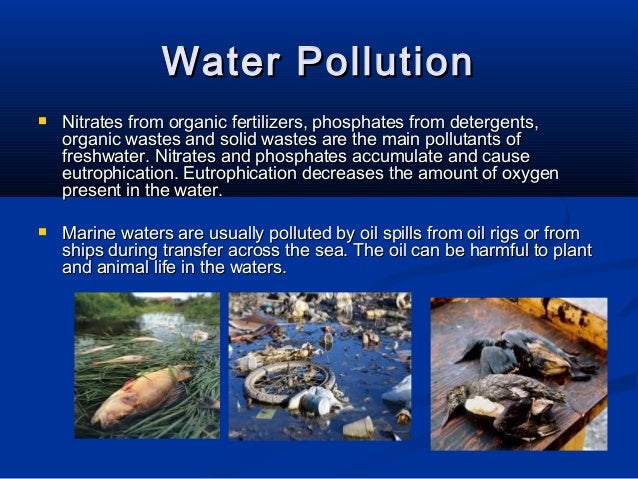Navigation menu
Human activities consume and destroy natural resources. For example, agriculture (and agroforestry) largely destroys lands and forests for food and cash cropping. Small-scale artisanal mining for gold and silver, such as that carried out in Peru, Colombia, Tanzania, and Guyana, destroys streams, rivers, forests, kills fish, and pollutes air, waterways, and soils with cyanide In , The New York Times stated that the inhabitants of the developed nations of the world consume resources like oil and metals at a rate almost 32 times greater than those of the developing world, who make up the majority of the human population. [24] Reduction of one's carbon footprint for various actions • Nonrenewable resources cannot be replaced by natural processes at the same rate as they are used. • Fossil fuels, such as oil, coal, rocks, minerals, and natural gas, are examples of nonrenewable resources. • A fossil fuel is an energy resource that formed from the remains of organisms that lived millions of years ago

Recommended
This is due to human activities like travel, power generation, industrial waste dumped into rivers, polyethylene waste, deforestation, nuclear testing, automobiles, industrialisation, artificial Geo-diversity resources is the Earth’s materials, forms and processes that constitute and shape the Earth. Some examples of natural Earth materials are minerals, rocks, sediments, fossils, soil and water. Some examples of forms comprise of folds, fault and landforms. Examples of processes include tectonics and sediment transport. 2 · Natural resources refer to the resources that exist on Earth independent of any human actions. These generally fall under one of two categories: renewable and non-renewable resources. Natural resources are also the essence behind what forms mother Earth. These include air, water, soil, minerals, as well as metals

You are here
· Human activities have often led to the loss of soil resources, which are the basis for sustained food security. Soil occurs naturally from physical and chemical disintegration of rocks and minerals combined with fossil. Because of such a combination, soil has different properties. Nowadays human activities repeatedly destroy soil resource · Natural resources refer to the resources that exist on Earth independent of any human actions. These generally fall under one of two categories: renewable and non-renewable resources. Natural resources are also the essence behind what forms mother Earth. These include air, water, soil, minerals, as well as metals • Nonrenewable resources cannot be replaced by natural processes at the same rate as they are used. • Fossil fuels, such as oil, coal, rocks, minerals, and natural gas, are examples of nonrenewable resources. • A fossil fuel is an energy resource that formed from the remains of organisms that lived millions of years ago

Global Warming
Human activities consume and destroy natural resources. For example, agriculture (and agroforestry) largely destroys lands and forests for food and cash cropping. Small-scale artisanal mining for gold and silver, such as that carried out in Peru, Colombia, Tanzania, and Guyana, destroys streams, rivers, forests, kills fish, and pollutes air, waterways, and soils with cyanide In , The New York Times stated that the inhabitants of the developed nations of the world consume resources like oil and metals at a rate almost 32 times greater than those of the developing world, who make up the majority of the human population. [24] Reduction of one's carbon footprint for various actions • Nonrenewable resources cannot be replaced by natural processes at the same rate as they are used. • Fossil fuels, such as oil, coal, rocks, minerals, and natural gas, are examples of nonrenewable resources. • A fossil fuel is an energy resource that formed from the remains of organisms that lived millions of years ago

Primary tabs
This is due to human activities like travel, power generation, industrial waste dumped into rivers, polyethylene waste, deforestation, nuclear testing, automobiles, industrialisation, artificial Human activities consume and destroy natural resources. For example, agriculture (and agroforestry) largely destroys lands and forests for food and cash cropping. Small-scale artisanal mining for gold and silver, such as that carried out in Peru, Colombia, Tanzania, and Guyana, destroys streams, rivers, forests, kills fish, and pollutes air, waterways, and soils with cyanide · Natural resources refer to the resources that exist on Earth independent of any human actions. These generally fall under one of two categories: renewable and non-renewable resources. Natural resources are also the essence behind what forms mother Earth. These include air, water, soil, minerals, as well as metals
No comments:
Post a Comment